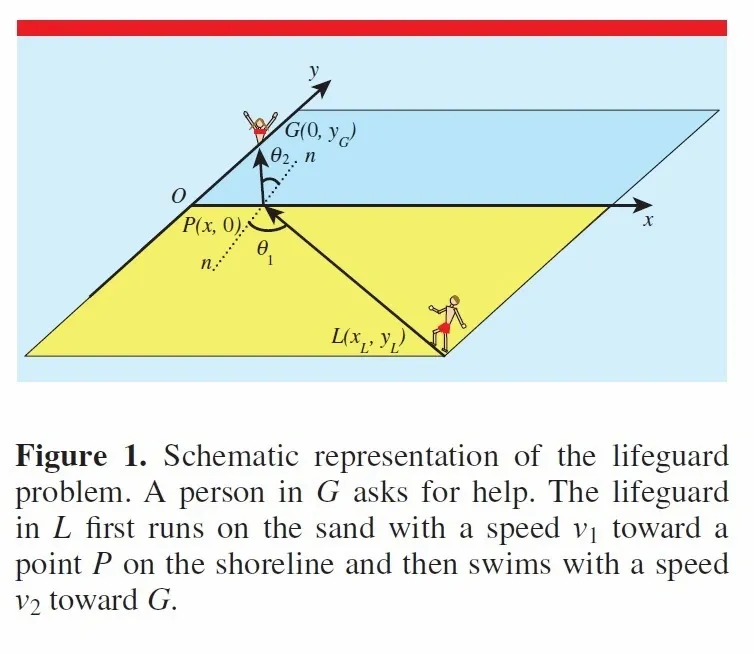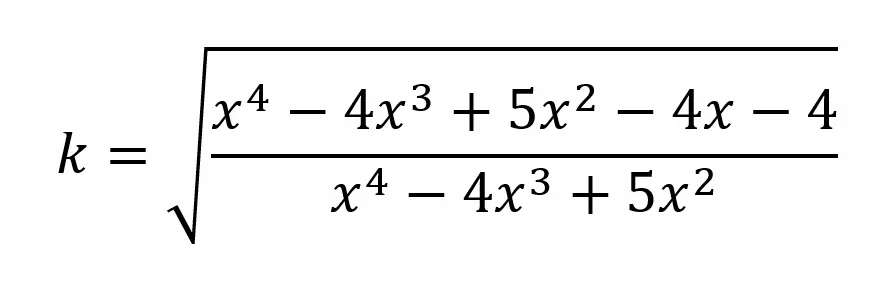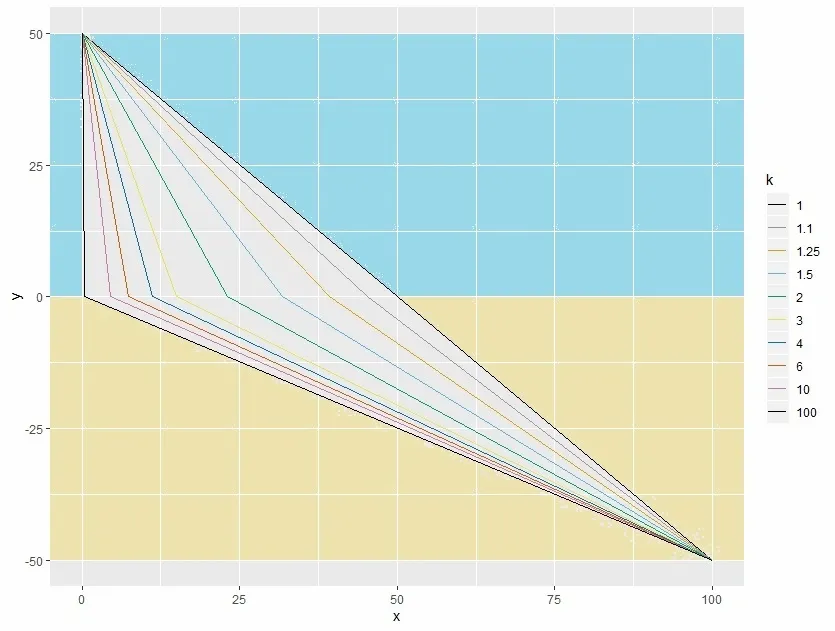
The Lifeguard Problem is one of those classic problems that engineering professors love to assign. Given a person in need of rescue, at what point should the lifeguard enter the water? If she can swim fast as she can run, then she should take the shortest path – a straight line. But since she can actually run faster than she can swim, she should take a path like the one in the image above, one that gives her more running time and less swimming time.
The person who originally introduced me to this problem told me that the math was extremely complicated, but that dogs knew how to solve it intuitively. I am not sure about the dogs, but I would disagree that the math is extremely complicated. Moderately complicated, sure.
Define k as the ratio of running-to-swimming speed, and x as the entry point into the water, where x=0 is where the swimmer is, and x=1 is the point on the straight line between the lifeguard and swimmer, then it is possible to find x for any value of k.
The equation is:

which I got from a recent paper by Roberto De Luca, Marco Di Mauro and Adele Naddeo in Physics Education (it’s their equation 6, which I’ve solved for k ). The figure at the top of the post comes from the same paper. What’s interesting, and not necessarily intuitive, is that the point of entry does not depend on how far from the water the lifeguard is, or how far from the shore the swimmer is.
If we graph the solution for various values of k, we get the following:

This was generated in R, but I used good old MS Paint to fill in colors suggesting sand and water to make it easier to understand. k=4 seems to be a typical value based on perusing some triathlon split times, and k=4 corresponds to the dark blue line toward the left side of the figure. This means the lifeguard should run most of the way before getting in the water – 78% of the horizontal distance, to be exact. If our lifeguard can manage 100 meters in 15 seconds on land and 60 seconds in the water, then following the perfect route would take 44.7 seconds in this example.
Supposing our lifeguard is oblivious to the lifeguard problem and decides to just take the shortest route possible – the straight line from her to the victim, corresponding to the black line. It’s a shorter distance, but more of it is in the water. This route would take 53.0 seconds, more than 8 seconds longer. Supposing instead she errs at the other extreme – in order to minimize the swimming distance, she runs until she is exactly aligned with the swimmer, at x=0. This is much better than the straight line route, but not the best, as the amount of extra running outweighs the savings in swimming. The time here would be 46.8 seconds.
I am not sure how lifeguards respond in real life, but a “three-quarters” rule seems like a good rule of thumb to save a few seconds. That is, enter the water three-quarters of the way to the victim, 78% being overprecise.
A follow-up post will include the R code used to generate the figure.

Hi. I do not know what Pumphandle stands for, but i love the fact that “Pump” is in your name! This is why:
I stumbled on your lifeguard problem solution today, after making my own solution today. My business name is Grunter Pumps ! (lol)
Reason i am looking further, is to see if there really is no one on earth that solved the life guard problem in a way that can actually be used by lifeguards. Mine can. Thanks for article.
LikeLike
Pumphandle is a reference to John Snow’s discovery that cholera was water-borne, which led him to remove the handle of the pump from a contaminated well in London in 1854. This is often considered the origin of the field of epidemiology. I would like to see your solution!
LikeLike
Hi. I wrote a little Lifeguard web app to do the calculations on the test data. All seems fine. I put up my entire solution to the lifeguard problem, as 1 large image at http://tiny.cc/grunterpumps
HOPE IT HELPS !
LikeLike
Hi. Thanks for your reply. Interesting about your name.
I have completely changed my calculation methodology since i first contacted you. For me personally, it is a whole lot easier now. Either no one does it my way, or they are not talking about it. That rattles me a bit.
I am 99.9999% sure that it will work, but i want to create a web app to test everything before i disclose all the info.
I will put it on its own website, perhaps with a password, which i will give you.
It will just be a long image or series of images with text on them. The bulk of it has already been created.
Thanks for your interest. Hang in there. Hope to get back to you soon.
George in Plett
LikeLike